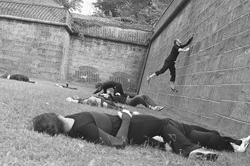Governors Island inspires visions of war and water
Last summer, Aviva Davidson’s Dancing in the Streets organization launched “Breaking Ground–A Dance Charrette”––a new project that substantially raised the bar for site-specific dance in this city. Joanna Haigood––artistic director of “Breaking Ground,” noted for her own such work in San Francisco–dreamt up the idea of selecting an interesting historic structure slated for a new use or major renovation and allowing five choreographers to explore its possibilities as a setting for performance.
Each artist would be challenged to whip up a finished five-to-ten-minute piece in just five days. The choreographers would neither see the site nor learn its identity until the start of this intensive work period––hence the adopted name “charrette,” which refers to a similar rush job by a team of architects. Of necessity, potential audiences would also be kept in the dark until the location was revealed to the choreographers and formally announced in the press and online.
Last year’s program––featuring choreographers as diverse as Eiko & Koma, Jawole Willa Jo Zollar, and Tere O’Connor––unfolded under the blistering sun in the remains of a former tobacco warehouse, a constrained wedge of space in a park between the Manhattan and Brooklyn Bridges. This summer, audiences ferried from lower Manhattan to Governors Island, then roamed around massive Fort Jay to see dances by Reggie Wilson, Elizabeth Streb, Noémi Lafrance, Yasuko Yokoshi, and Douglas Dunn. The weather was kinder, the site more generous in its variety, and the creations, in almost every case, far more inspired.
We entered through a fence and skirted the fort’s pentagram-shaped moat, picking our way amid patchy grass, dirt, and Canadian goose droppings. Wilson’s trio––“L. Moat (East) 8-19-06”––began far ahead of us. Drawn on by a haunting call-and-response that could have been sung by African slaves, we raced toward it. But instead of finding Wilson with Elaine Flowers and Michel Kouakou burdened by loads of bricks, we came upon a more laidback scene––dancers calmly striding the moat, running along the bastion’s wall, tossing bottles of spring water to one another and onto beach towels, balancing bottles on their heads while steadily pacing the grass or rotating their hips, or mischievously knocking the bottles off. Wilson’s deliciously cheeky response to Fort Jay invoked the resilient spirit of its builders while humorously acknowledging the water that once gave it some measure of protection. And through it all––as is customary in Wilson’s work––singing and chant layered everything in deep memory, heart, and spirituality.
Elizabeth Streb landed the project’s most compact and dramatic locale––the fort’s western, arched entranceway with its darkened cement tunnel that inclines 35 degrees. In “TunnelVision,” Streb repeatedly crawled up and rolled back down this passageway while symbolically threatening planks fell, little rubber balls bounced, stones tumbled, and water gushed from overhead or poured down the tunnel. It was totally Streb––an uncanny mixture of gutsy struggle and child’s play––and when it was over, some of us rushed forward to hug her, as grimy and drenched as she was.
LaFrance launched her “Invasion”—the day’s simplest conception, rushes of energy––in another section of the moat, sending wave upon wave of dancers leaping into the ditch, dashing against the wall, slipping to the grass, retreating, and charging again until all finally collapsed, vanquished.
By contrast, Yokoshi––portraying a distraught child—crammed an entire costume drama into her segment, which alluded to World War II air raids in Japan and the disruption of families. Yokoshi’s piece, “Lost,” stretched across two long arms of the wall’s grassy slopes, requiring us to frequently swivel our heads to keep up with bits of action and blasts of sound popping up here and there.
Having begun with Wilson’s soothing vibrations, “Breaking Ground” concluded with Douglas Dunn’s equally peaceable “Glass Sea” in the safety of the fort’s courtyard. Dunn must have paid the mockingbird—one with but a single, piercing call––that flitted from tree to tree, providing the soundtrack for this elfin, twisty, occasionally sensual abstract work for a brightly colored ensemble of five. Far from history, drama, and struggle, Dunn seemed to say, let me dance and make dances as free as the river breeze.
gaycitynews.com




































